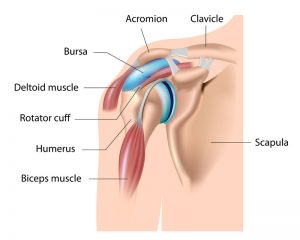Shoulder Pain is a common problem that can lead to chronic pain and functional impairment if left  untreated. A common reason for shoulder pain is a condition called impingement syndrome. This syndrome is actually a continuum of separate anatomical injuries and the body’s reaction to these injuries. The risk of developing this syndrome increases as an individual ages. Although it may occur after an isolated injury it more commonly develops over time due to repeated micro trauma (small injuries.)
untreated. A common reason for shoulder pain is a condition called impingement syndrome. This syndrome is actually a continuum of separate anatomical injuries and the body’s reaction to these injuries. The risk of developing this syndrome increases as an individual ages. Although it may occur after an isolated injury it more commonly develops over time due to repeated micro trauma (small injuries.)
The underlying problem is a narrowing of the space occupied by the rotator cuff tendon and bursa of the shoulder. This space is bordered by the humerus (bone of the upper arm) and the acromion (top bone of the shoulder girdle.) When this subacromial space decreases in size the rotator cuff tendon and the bursa may become pinched between these two bones when the arm is raised forward or to the side. This pinching or impingement causes severe pain and can lead to weakness.
Repetitive impingement of the rotator cuff tendon and bursa results in inflammation of both the rotator cuff tendon and bursa leading to rotator cuff tendonitis and bursitis. Tendonitis and bursitis are both very painful conditions. They add to the pain of impingement syndrome and may also lead to a thickening of these structures, thereby making impingement with arm elevation more likely. If left untreated the repetitive trauma to the rotator cuff tendon may result in rotator cuff tearing.
The common symptoms of impingement syndrome include dull achy shoulder pain at rest, night pain, sharp pain and weakness with lifting, reaching and overhead activities, and referred pain to the lateral upper arm.
Despite the complex nature of impingement syndrome most people can be successfully treated without surgery. Initial treatment consists of activity modification, physical therapy, anti-inflammatories and cortisone injections.
When z three to six month trial of conservative treatment fails then surgical options are explored. The surgical treatment is done arthroscopically and uses very small incisions, resulting in less pain and a quicker recovery. The surgical procedure involves shaving some of the acromion bone and removing the bursa to increase the subacromial space. The rotator cuff is inspected at the time of surgery and partial tearing is treated by removing the torn free edges of the rotator cuff while full thickness tears are repaired.
Impingement syndrome commonly develops over time without a known injury. People often suffer with pain in the hopes that it will improve over time. The opposite usually occurs and the pain increases while shoulder strength and function deteriorate. Presently, a high percentage of patients can be treated successfully without recourse to surgery, however, when surgery is required the arthroscopic approach results in small incisions, less postoperative pain and a faster recovery.
 Dr. Paul Morin is a Board Certified Orthopedic Surgeon specializing in Sports Medicine. For more information or to schedule a quick appointment, please call 863-293-1191 ext3530. You may also view Dr. Morin’s credentials by reviewing his profile.
Dr. Paul Morin is a Board Certified Orthopedic Surgeon specializing in Sports Medicine. For more information or to schedule a quick appointment, please call 863-293-1191 ext3530. You may also view Dr. Morin’s credentials by reviewing his profile.
 Treating you well since 1948
Treating you well since 1948 


